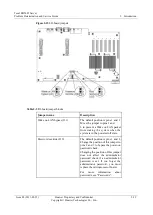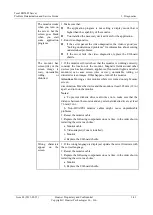
Tecal RH5485 Server
Problem Determination and Service Guide
3 Diagnostics
Issue 02 (2011-05-25)
Huawei Proprietary and Confidential
Copyright © Huawei Technologies Co., Ltd.
3-31
Energy
Manager > Capping Enabled
.
3. Update the server firmware.
4. Update the IMM firmware.
3.4 Checkout procedures
The checkout procedure is the sequence of tasks that you should follow to diagnose a
problem in the server.
3.4.1 About the checkout procedure
Before you perform the checkout procedure for diagnosing hardware problems, review the
following information:
Read the safety information.
A single problem might cause more than one error message.
When this happens, correct the cause of the first error message. The other error
messages usually will not occur the next time.
Exception:
If multiple error codes or light path diagnostics LEDs indicate a
microprocessor error, the error might be in a microprocessor or in a
microprocessor
socket. See “Microprocessor problems” for information about diagnosing
microprocessor problems.
Before you run the diagnostic programs, you must determine whether the failing server is
part of a shared hard disk drive cluster (two or more servers sharing external storage
devices). If it is part of a cluster, you can run all diagnostic programs except the ones that
test the storage unit (that is, a hard disk drive in the storage unit) or the storage adapter
that is attached to the storage unit. The failing server might be part of a cluster if any of
the following conditions is true:
−
You have identified the failing server as part of a cluster (two or more servers sharing
external storage devices).
−
One or more external storage units are attached to the failing server and at least one
of the attached storage units is also attached to another server or unidentifiable
device.
−
One or more servers are located near the failing server.
CAUTION
If the server is part of a shared hard disk drive cluster, run one test at a time. Do not run any
suite of tests, such as “quick” or “normal” tests, because this might enable the hard disk drive
diagnostic tests.
In a two-node configuration, be sure to check the LEDs and view the logs on both
servers to determine whether the error occurred on the primary or secondary server.
















































